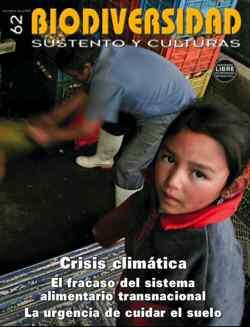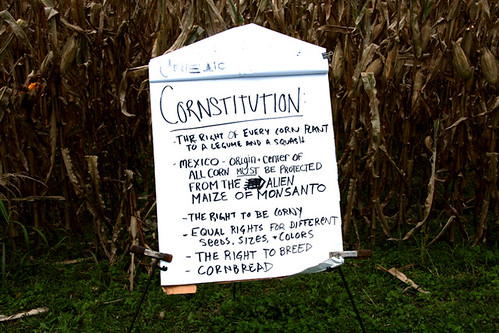RENACE
RED NACIONAL DE ACCION ECOLOGISTA
De la Argentina
17 octubre 09
REENVIAMOS
aaA Acerca del Congreso Forestal Mundial
ENCUENTRO POR LA VIDA Y CONTRA LOS AGRONEGOCIOS
Los arboles son mucho más que madera
Por: Javier Souza Casadinho Coordinador regional RAPAL
Se desarrolla en Argentina el XX congreso forestal mundial promovido por organizaciones internacionales y empresas que favorecen y se enriquecen con los agronegocios. Este hecho no puede pasar desapercibido dado que uno de los objetivos de este encuentro es promover el monocultivo de arboles exóticos o importados con lo cual se alteran gravemente las relaciones al interior de los ecosistemas naturales y con ello la vida misma. En este proceso creciente de cultivo de árboles, la expansión productiva ocurre en una estructura agraria en la cual se manifiesta una creciente concentración económica, afectando de esta manera a miles de productores, principalmente a los más pequeños. Se hace presente y visible la desnacionalización de la producción agrícola y su inclusión en un complejo agroindustrial ligado a la oferta monopólica de insumos y tecnologías – semillas y maquinarias-. Complejo impulsado y en manos de unas pocas empresas extranjeras.
Alunas preguntas que debemos hacernos
¿Cómo afecta la deforestación a los ecosistemas?
Unida a los procesos de expansión de la frontera agropecuaria se asiste a un proceso de eliminación creciente de los bosques, selvas y montes nativos, para implantar árboles que provienen de otros lugares del mundo –exóticos-. Árboles y arbustos son arrancados y con ellos se afecta a todos los ecosistemas que los posee como componentes indispensables.
Cuando se elimina un árbol se afecta a todo el ecosistema, desde las pequeñas bacterias que se alimentaban de las hojas que caían al suelo – reciclando los nutrientes -, hasta las abejas que anidaban en sus ramas, las plantas herbáceas que crecían a su sombra y aún los pequeños animales que residían sobre las ramas y en el mismo tronco. Además como elemento regulador del clima; los árboles proveen sombra, con sus hojas protegen al suelo de las gotas de lluvia y aún regulan la escorrentía, la infiltración y almacenamiento del agua.
¿Cómo afectan los monocultivos de árboles a la alimentación de las comunidades?
Arrancados los árboles las comunidades ya no pueden obtener de ellos su alimento, tampoco podrán curarse y además ya no accederán a la miel, pequeños animales y plantas herbáceas que el monte o bosque eran capaces de proveer. Luego de un par de años de monocultivo herbáceo, los suelos pierden rápidamente la fertilidad, volviéndose polvorientos, sin vida, incapaces de sostener la nutrición de los cultivos que sobre ellos se cultiven. Estos cultivos desplazan a cultivos como la papa, la batata, la mandioca, o el maíz, cultivos arraigados en las comunidades, capaces de prepararse y combinarse de diferente manera según los usos y las costumbres propios de cada una de ellas.
¿Existen árboles transgénicos? ¿Como pueden afectarnos?
Los organismos transgénicos son aquellos que han sido modificados en su estructura genética de tal manera que expresen una característica que naturalmente no poseían-. Aunque en la actualidad no hay plantaciones legales de este tipo en la región, si hay estudios de investigación para poder desarrollarlos y cultivarlos a campo.
La utilización de plantas transgénicas determina que nuestros suelos y el esfuerzo de las comunidades se destinen a producir plantas para alimentar a cerdos y vacas chinas y Europeas mientras que las comunidades americanas consumen alimento s de baja calidad nutritiva. Esto es lo que viene sucediendo con el modelo productivo basado en la soja transgénica en los países del cono sur de Latinoamérica.
¿La implantación de árboles exóticos promueve el uso de plaguicidas?
Los monocultivos no poseen la capacidad de sustentarse por sí mismos por lo cual requieren de aportes crecientes, de la protección permanente, de plaguicidas. El modelo de monocultivos forestales ha determinado un sobre uso de plaguicidas en especial de herbicidas – como el glifosato - y de insecticidas –como el mirex-. Es sabido que los herbicidas no solo eliminan, y solo parcialmente, a las mal llamadas malezas sino que eliminan una gran cantidad de hierbas silvestres capaces de alimentar a las poblaciones rurales y periurbanas. Además estos “yuyos” proveen alimentos y cobijo a una gran cantidad de insectos benéficos indispensables en los agroecosistemas.
Los plaguicidas contaminan al ambiente afectando especialmente a los seres humanos. Pueden aparecen dos tipos de intoxicaciones; las de rápida manifestación - agudas - cuyos síntomas son los vómitos, las diarreas y las que aparecen mucho tiempo después del contacto – las crónicas -. Estas últimas pueden determinar la aparición de canceres, mal de Parkinson, etc. El caso del mirex, utilizado para controlar hormigas, es el más preocupante dado que se trata de un tóxico persistente, acumulándose en las cadenas tróficas, viajando a grandes distancias y resistiendo a la degradación química, física y biológica.
5-¿La forestación con monocultivos afecta el acceso a la tierra de las comunidades?
El monocultivo de árboles expulsa a los pueblos ya por que requiere sus tierras como porque afecta a la alimentación. Para poder producir las comunidades necesitan acceder a la tierra y al agua en cantidades suficientes según los cultivos y sistemas productivos que en cada comunidad suelen practicarse. Si bien el problema del acceso a la tierra se remonta a los orígenes mismos de los procesos de colonización europea cuando los pueblos originarios fueron despojados de sus tierras, en la actualidad este proceso se continua y profundiza a partir de la expansión de la frontera agropecuaria – incluido el cultivo de árboles - . Así las comunidades despojadas de su tierra no solo ya no pueden cultivar los cultivos destinados a la venta y los destinados al autoconsumo sino que tampoco pueden acceder a las especies vegetales silvestres, árboles, plantas herbáceas, pequeños animales, etc. Se desencadenan así migraciones internas desde las comunidades a grandes centros urbanos con lo cual se interrumpen vínculos con el territorio y se incrementa la población en las ciudades
6-¿Qué es y que rol juegan las Certificaciones Forestales?
Debido al avance de la forestación, surge un pedido de distintas voces de todos los campos sociales (consumidores, ambientalistas, ONG´s, comunidades afectadas) para que los productos derivados de árboles tengan certificaciones que demuestre el manejo responsable de los ambientes donde se realizan el cultivo y las extracciones. Surge así el FSC (Consejo de Administración Forestal) que certifica un manejo ambiental sustentable, beneficioso socialmente y económicamente viable para los bosques del mundo. El hecho de destacar y dudar de estas certificadoras, es que NO son un órgano estrictamente independiente, ni incluye en su estructura de monitoreo y evaluación a las comunidades locales y el ambiente. Además en esta certificación se permite el uso de plaguicidas de alto impacto en el ambiente, incluida la salud de las personas. El FSC también es cuestionado por que sus intenciones de certificar vienen relacionadas con las grandes corporaciones económicas interesadas en la producción forestal y que sus definiciones de plantaciones sustentables, distan muy lejos de lo que las comunidades piensan y desean.
7-¿La forestación con especies exóticas afecta a las variedades nativas de árboles?
Se asiste a un proceso de desaparición creciente de árboles criollos. Desde la revolución verde iniciada a principios de la década del 50´ se da un largo y constante proceso de introducción de semillas mejoradas, semillas “milagrosas” que acompañadas de un paquete tecnológico basado en plaguicidas, fertilizantes y maquinaria han determinado el reemplazo y pérdida de semillas criollas adaptadas al clima, ecosistemas y culturas locales.
Los árboles nativos se hallan adaptados al clima y al suelo, recreando a su alrededor verdaderos ecosistemas integrados por otros vegetales, insectos, bacterias, mamíferos – incluidos nosotros -. Todos ellos se relacionan de manera armónica obteniendo alimento y espacio para vivir. Reemplazados los arboles nativos por los importados se acaban las relaciones determinando la desaparición de cadenas alimentarias integras, afectando principalmente a los seres humanos
8-¿Se relaciona la forestación con la aparición de enfermedades?
Las causas que determinan la aparición de enfermedades son múltiples pero se relacionan entre sí. Como se sabe el progreso del dengue tiene que ver con la expansión de las zonas de distribución y las posibilidades de supervivencia del mosquito Aedes aegypty, ambas se hallan relacionadas con el modelo agrícola vigente y el cambio climático, estas a su vez vinculadas entre sí. Si bien es posible hablar de la multicausalidad de las enfermedades es indudable que el modelo productivo basado en los monocultivos, la utilización de herbicidas, fungicidas e insecticidas posee su impacto en la tasa de reproducción y supervivencia del vector.
En primer lugar la deforestación y quema de bosques y montes, para dedicar las tierras al cultivo de árboles exóticos, ha determinado la migración de los mosquitos hacia otras zonas donde han encontrado condiciones óptimas para su supervivencia. En este caso también posee una notable influencia el cambio climático en especial la elevación de las temperaturas y el cambio en las condiciones de humedad. Ahora bien el cambio climático no ha ocurrido naturalmente o por azar, por el contrario se relaciona tanto con el incremento en las actividades industriales, los transportes, la quema de bosques que generan dióxido de carbono como con el descenso en la superficie cubierta por árboles, que absorben ese compuesto.
9-¿Cuál es el rol de los árboles en los ecosistemas?
Los arboles poseen un papel claro e irremplazable en la elevación de la productividad del sistema y en la mantención del equilibrio biológico. Dado que las raíces son capaces de explorar el perfil del suelo hasta por una profundidad que excede los 5 metros constituyen una excelente bomba de nutrientes hacia la superficie. Allí los nutrientes quedan a disposición de plantas de crecimiento radicular más pequeño. La generación de un micro hábitat favorable dado por la sombra, mayor cantidad de nutrientes y disponibilidad de agua propicia el crecimiento de otras especies silvestres y/o cultivadas. Se observa la recomposición paulatina de los contenidos de materia orgánica de suelo mejorando sus características químicas, físicas y biológicas.
10 ¿Qué podemos hacer para revertir la situación?
El entramado de causas internas y externas con origen en el desarrollo de políticas desacertadas hace necesario tener en cuenta una política clara y definida respecto al resguardo y promoción de los árboles nativos.
Si bien el respeto permite la no invasión sobre los modos de producción y elaboración de los alimentos se hace necesario el desarrollo de una política integral con medidas que no solo protejan, sino promuevan la soberanía alimentaria:
Entre otros temas debemos pensar, luchar y discutir sobre:
a-El acceso a la tierra y al agua en cantidad y calidad suficiente para el sustento de las comunidades.
b-La protección de los bosques y montes nativos creadores y dadores de vida
c-La promoción de la agroecología como modo de cultivo y de vincularnos con el ambiente no solo por que permite la producción de alimentos de alta calidad e inocuidad sino porque respetan los ciclos naturales y los conocimientos de los pueblos.
d-La promoción de las rotaciones y los policultivos incluyendo árboles a fin de favorecer una adecuada nutrición de los suelos y el manejo ecológico de los insectos y enfermedades.
e-La valoración de los arboles criollos como integrantes fundamentales de los ecosistemas, fuentes apropiadas de alimentos no solo por que se hallan adaptadas a los suelos y clima local sino porque pueden procesarse de múltiples formas, potencializando su capacidad alimentaria.
f-La promoción de las ferias de semillas como instancia de encuentro de saberes y haceres en torno a la producción de cultivos y elaboración de alimentos.
g-El mantenimiento de áreas de monte, bosque y selva indispensables para el equilibrio de los sistemas y la continuidad de la vida de las poblaciones que allí se asientan desde tiempos inmemoriales
Marcos paz , 15 de octubre de 2009
CONTACTOS PARA PRENSA
Javier Souza - RAPAL javierrapal@yahoo.com.ar
Carlos Vicente - GRAIN / ACCION POR LA BIODIVERSIDAD - RENACE (011) 156 3088809 carlos@grain.org
WRM Movimiento Mundial por los Bosques - Uruguay (+ 598 98) 407572 wrm@wrm.org.uy
www.renace.net







